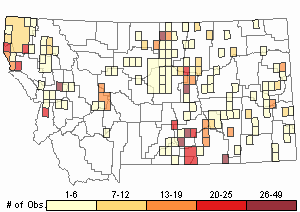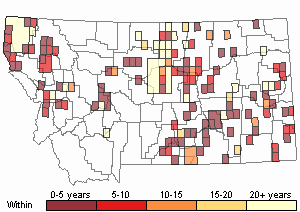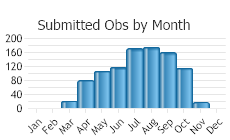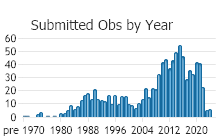View in other NatureServe Network Field Guides
NatureServe
Montana
Utah
Wyoming
Idaho
Wisconsin
British Columbia
South Carolina
Yukon
California
New York
Largemouth Bass - Micropterus nigricans
General Description
The largemouth bass is the largest and most widely acclaimed gamefish in the sunfish family. Largemouth are true warmwater fish, thriving in temperatures up to 90 F in their native southeastern U.S. The largemouth bass may be the most widely introduced species in North America and are now found virtually all across the continent as well as east and west of the Divide in Montana. Another spring spawning nest-builder, the largemouth bass prefers habitat that is very warm, such as weedy ponds or sloughs. They are seldom found in rivers or in waters deeper than 20 feet. An aggressive and opportunistic surface-feeder, largemouth bass are primarily fish-eaters. They also will eat nearly any other water-borne animal on occasion. The Montana record largemouth bass is a little over 8 pounds, but the world record is 22 pounds. Largemouth bass do well in many marginal trout ponds but are subject to winterkill and often need to be restocked.
Diagnostic Characteristics
Length of the longest dorsal spine at least twice the length of the shortest dosal spine at notch. Young have a bicolored tail, the rear being darker than the front.
Species Range
Montana Range
Range Descriptions

 Non-native
Non-native
Observations in Montana Natural Heritage Program Database
Number of Observations: 980
(Click on the following maps and charts to see full sized version)
Map Help and Descriptions
Relative Density

Recency



 (Observations spanning multiple months or years are excluded from time charts)
(Observations spanning multiple months or years are excluded from time charts)
Habitat
Clear mud-bottomed lakes and stream backwaters. Seeks areas with comparatively warm summer water temperatures and ample aquatic vegetation.
Food Habits
Adults feed mostly on fishes. Minnows and suckers are the most frequent foods. Frogs and aquatic insects are also eaten. Young first feed on plankton.
Ecology
Grows slowly in Montana because of cold water temperatures.
Reproductive Characteristics
Sexually mature in 3-5 years. Spawns May-mid July. Eggs and fry cannot tolerate temperatures below 50 degrees F. Usually spawns at 62-65 degrees F. among emergent vegetation in quiet bays.
Management
Stewardship Responsibility
References
- Literature Cited AboveLegend:
 View Online Publication
View Online Publication Lee, D.S., C.R. Gilbert, C.H. Hocutt, R.E. Jenkins, D. E. McAllister, J. R. Stauffer, Jr. 1980. Atlas of North American freshwater fishes. North Carolina State Musuem of Natural History. 867 p.
Lee, D.S., C.R. Gilbert, C.H. Hocutt, R.E. Jenkins, D. E. McAllister, J. R. Stauffer, Jr. 1980. Atlas of North American freshwater fishes. North Carolina State Musuem of Natural History. 867 p. Scott, W.B. and E.J. Crossman. 1973. Rainbow trout, Kamloops trout, Steelhead trout Salmo gairdneri Richardson. pp. 184-191. In: Freshwater fishes of Canada. Ottawa, Canada: Fisheries Research Board of Canada, Bulletin 184. 966 p.
Scott, W.B. and E.J. Crossman. 1973. Rainbow trout, Kamloops trout, Steelhead trout Salmo gairdneri Richardson. pp. 184-191. In: Freshwater fishes of Canada. Ottawa, Canada: Fisheries Research Board of Canada, Bulletin 184. 966 p.
- Additional ReferencesLegend:
 View Online Publication
View Online Publication
Do you know of a citation we're missing? Craig, V.E. 1952. A story of fish production as it applies to Montana. M.Sc. Thesis. Bozeman, MT: Montana State University. 92 p.
Craig, V.E. 1952. A story of fish production as it applies to Montana. M.Sc. Thesis. Bozeman, MT: Montana State University. 92 p. Duncan, M.B. 2019. Distributions, abundances, and movements of small, nongame fishes in a large Great Plains river network. Ph.D. Dissertation. Bozeman, MT: Montana State University. 255 p.
Duncan, M.B. 2019. Distributions, abundances, and movements of small, nongame fishes in a large Great Plains river network. Ph.D. Dissertation. Bozeman, MT: Montana State University. 255 p. Evenson, E.J. 1978. The dietary effects of Rana catesbeiana on Micropterus salmoides. M.S. Thesis. University of Nebraska at Lincoln. 24 pp.
Evenson, E.J. 1978. The dietary effects of Rana catesbeiana on Micropterus salmoides. M.S. Thesis. University of Nebraska at Lincoln. 24 pp. Holton, G.D. 1981. Identification of Montana's most common game and sport fishes. Montana Outdoors May/June reprint. 8 p.
Holton, G.D. 1981. Identification of Montana's most common game and sport fishes. Montana Outdoors May/June reprint. 8 p. Jones, Thomas S. 1991. Floodplain distribution of fishes of the Bitterroot River with emphasis on introduced populations of Northern Pike. M.S. Thesis. University of Montana. Missoula, MT.
Jones, Thomas S. 1991. Floodplain distribution of fishes of the Bitterroot River with emphasis on introduced populations of Northern Pike. M.S. Thesis. University of Montana. Missoula, MT. Joslin, Gayle, and Heidi B. Youmans. 1999. Effects of recreation on Rocky Mountain wildlife: a review for Montana. [Montana]: Montana Chapter of the Wildlife Society.
Joslin, Gayle, and Heidi B. Youmans. 1999. Effects of recreation on Rocky Mountain wildlife: a review for Montana. [Montana]: Montana Chapter of the Wildlife Society. Kirk, W.L. 1964. The nutritional value of bullfrog tadpoles (Rana catesbeiana) as forage for the largemouth bass (Micropterus salmoides). M.S. Thesis, Southern Illinois University. 29p.
Kirk, W.L. 1964. The nutritional value of bullfrog tadpoles (Rana catesbeiana) as forage for the largemouth bass (Micropterus salmoides). M.S. Thesis, Southern Illinois University. 29p. Lewis, W.M., G.E. Gunning, E. Lyles, and W.L. Bridges. 1961. Food choice of largemouth bass as a function of availability and vulnerability of food items. Transactions of the American Fisheries Society 90(3): 277-280.
Lewis, W.M., G.E. Gunning, E. Lyles, and W.L. Bridges. 1961. Food choice of largemouth bass as a function of availability and vulnerability of food items. Transactions of the American Fisheries Society 90(3): 277-280. Montana Fish, Wildlife and Parks. 1989. Hauser Reservoir fisheries management plan: September 1989-September 1994. 16 p.
Montana Fish, Wildlife and Parks. 1989. Hauser Reservoir fisheries management plan: September 1989-September 1994. 16 p. Penkal, R.F. 1977. Black bass populations of the Tongue River Reservoir, Montana. M.Sc. Thesis. Bozeman, MT: Montana State University. 111 p.
Penkal, R.F. 1977. Black bass populations of the Tongue River Reservoir, Montana. M.Sc. Thesis. Bozeman, MT: Montana State University. 111 p. Rahrer, J.F. 1963. Age and growth of four species of fish, Flathead Lake, Montana. M.Sc. Thesis. Bozeman, MT: Montana State University. 16 p.
Rahrer, J.F. 1963. Age and growth of four species of fish, Flathead Lake, Montana. M.Sc. Thesis. Bozeman, MT: Montana State University. 16 p. Sylvester, R. and B. Marotz. 2006. Evaluation of the Biological Effects of the Northwest Power Conservation Council's Mainstem Amendment on the Fisheries Upstream and Downstream of Hungry Horse and Libby Dams, Montana. Montana Fish, Wildlife, and Parks Annual Report prepared for U.S. Department of EnergyBonneville Power Administration. Bonneville Power Administration Project No. 2006-008-00 Contract No. 28350. 124 p.Contract No. 28350
Sylvester, R. and B. Marotz. 2006. Evaluation of the Biological Effects of the Northwest Power Conservation Council's Mainstem Amendment on the Fisheries Upstream and Downstream of Hungry Horse and Libby Dams, Montana. Montana Fish, Wildlife, and Parks Annual Report prepared for U.S. Department of EnergyBonneville Power Administration. Bonneville Power Administration Project No. 2006-008-00 Contract No. 28350. 124 p.Contract No. 28350 Sylvester, R. and B. Stephens. 2011. Evaluation of the physical and biological effects of the Northwest Power Conservation Council's Mainstem Amendment upstream and downstream of Libby Dam, Montana. Libby, MT: Montana Fish, Wildlife, and Parks Annual Report prepared for U.S. Department of Energy Bonneville Power Administration. Bonneville Power Administration Project No. 2006-008-00, Contract Nos. 43309 and 48555. 282 p.
Sylvester, R. and B. Stephens. 2011. Evaluation of the physical and biological effects of the Northwest Power Conservation Council's Mainstem Amendment upstream and downstream of Libby Dam, Montana. Libby, MT: Montana Fish, Wildlife, and Parks Annual Report prepared for U.S. Department of Energy Bonneville Power Administration. Bonneville Power Administration Project No. 2006-008-00, Contract Nos. 43309 and 48555. 282 p. Sylvester, R., A. Steed, J. Tohtz, and B. Marotz. 2008. Evaluation of the Biological Effects of the Northwest Power Conservation Council's Mainstem Amendment on the Fisheries Upstream and Downstream of Hungry Horse and Libby Dams, Montana. Montana Fish, Wildlife, and Parks Annual Report prepared for U.S. Department of EnergyBonneville Power Administration. Bonneville Power Administration Project No. 2006-008-00 Contract No. 28350. 124 p.Contract No. 28350
Sylvester, R., A. Steed, J. Tohtz, and B. Marotz. 2008. Evaluation of the Biological Effects of the Northwest Power Conservation Council's Mainstem Amendment on the Fisheries Upstream and Downstream of Hungry Horse and Libby Dams, Montana. Montana Fish, Wildlife, and Parks Annual Report prepared for U.S. Department of EnergyBonneville Power Administration. Bonneville Power Administration Project No. 2006-008-00 Contract No. 28350. 124 p.Contract No. 28350 Tews, A.E. 1986. The water quality and fishery resource in a surface coal mine sediment pond in eastern Montana. M.Sc. Thesis. Bozeman, MT: Montana State University. 81 p.
Tews, A.E. 1986. The water quality and fishery resource in a surface coal mine sediment pond in eastern Montana. M.Sc. Thesis. Bozeman, MT: Montana State University. 81 p. USDI Bureau of Land Management. No date. Fishes of the Miles city, Montana BLM District. Miles City, MT: Miles City BLM District pamphlet. 12 p.
USDI Bureau of Land Management. No date. Fishes of the Miles city, Montana BLM District. Miles City, MT: Miles City BLM District pamphlet. 12 p. Waage, B.C. 1984. Western Energy Company Rosebud Mine, Rosebud County, Montana: Annual Wildlife Monitoring Report, 1983 Field Season. June 1984.
Waage, B.C. 1984. Western Energy Company Rosebud Mine, Rosebud County, Montana: Annual Wildlife Monitoring Report, 1983 Field Season. June 1984. Waage, B.C. 1986. Western Energy Company Rosebud Mine, Rosebud County, Montana: Annual Wildlife Monitoring Report, 1985 Field Season. December 1985.
Waage, B.C. 1986. Western Energy Company Rosebud Mine, Rosebud County, Montana: Annual Wildlife Monitoring Report, 1985 Field Season. December 1985. Waage, B.C. 1986. Western Energy Company Rosebud Mine, Rosebud County, Montana: Annual Wildlife Monitoring Report, 1986 Field Season. December 1986.
Waage, B.C. 1986. Western Energy Company Rosebud Mine, Rosebud County, Montana: Annual Wildlife Monitoring Report, 1986 Field Season. December 1986. Waage, B.C. 1987. Western Energy Company Rosebud Mine, Colstrip, Montana: Annual Wildlife Monitoring Report, 1987 Field Season. December 1987.
Waage, B.C. 1987. Western Energy Company Rosebud Mine, Colstrip, Montana: Annual Wildlife Monitoring Report, 1987 Field Season. December 1987. Waage, B.C. 1988. Western Energy Company Rosebud Mine, Colstrip, Montana: Annual Wildlife Monitoring Report, 1988 Field Season. December 1988.
Waage, B.C. 1988. Western Energy Company Rosebud Mine, Colstrip, Montana: Annual Wildlife Monitoring Report, 1988 Field Season. December 1988. Waage, B.C. 1989. Western Energy Company Rosebud Mine, Colstrip, Montana: Annual Wildlife Monitoring Report, 1989 Field Season. December 1989.
Waage, B.C. 1989. Western Energy Company Rosebud Mine, Colstrip, Montana: Annual Wildlife Monitoring Report, 1989 Field Season. December 1989. Walker-Smith, Kathleen. 1995. Environmental and biological factors limiting reproduction, recruitment and growth of Largemouth Bass in Seeley and Echo Lakes, Montana
Walker-Smith, Kathleen. 1995. Environmental and biological factors limiting reproduction, recruitment and growth of Largemouth Bass in Seeley and Echo Lakes, Montana Wollitz, R.E. 1958. The effects of certain commercial toxicants on limnology of 3 cold water ponds near Three Forks, Montana. M.Sc. Thesis. Bozeman, MT: Montana State University. 63 p.
Wollitz, R.E. 1958. The effects of certain commercial toxicants on limnology of 3 cold water ponds near Three Forks, Montana. M.Sc. Thesis. Bozeman, MT: Montana State University. 63 p. Workman, D.L. 1970. A comparison of fish population estimates for two pothole lakes in Montana. M.Sc. Thesis. Bozeman, MT: Montana State University. 26 p.
Workman, D.L. 1970. A comparison of fish population estimates for two pothole lakes in Montana. M.Sc. Thesis. Bozeman, MT: Montana State University. 26 p. Zollweg, E.C. 1998. Piscine predation on bull trout in the Flathead River, Montana. M.Sc. Thesis. Bozeman, MT: Montana State University. 97 p.
Zollweg, E.C. 1998. Piscine predation on bull trout in the Flathead River, Montana. M.Sc. Thesis. Bozeman, MT: Montana State University. 97 p. Zymonas, N.D. 2006. Age structure, growth, and factors affecting relative abundance of life history forms of Bull Trout in the Clark Fork river drainage, Montana and Idaho. M.Sc. Thesis. Bozeman, MT: Montana State University. 142 p.
Zymonas, N.D. 2006. Age structure, growth, and factors affecting relative abundance of life history forms of Bull Trout in the Clark Fork river drainage, Montana and Idaho. M.Sc. Thesis. Bozeman, MT: Montana State University. 142 p.
- Web Search Engines for Articles on "Largemouth Bass"
- Additional Sources of Information Related to "Fish"





